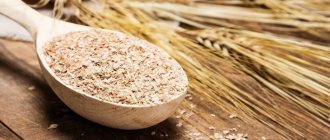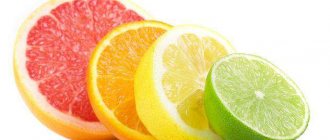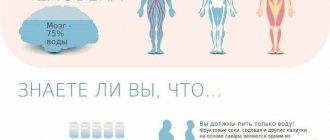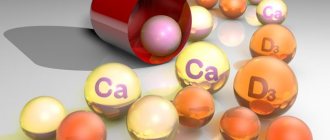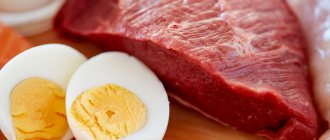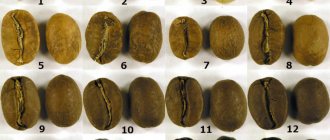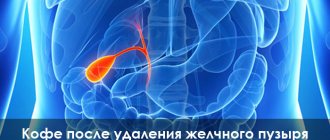Fluid retention in the body is an unpleasant phenomenon familiar to most people, especially women. It leads to swelling, which not only affects the appearance, but also increases the load on the internal organs. Difficulty removing fluid from the body is a symptom of some heart and kidney diseases. But most often this happens due to an incorrect lifestyle and because many do not know what foods retain water in the body. If edema has become a constant companion in life, first of all you need to adjust the menu, reducing or completely eliminating these particular products . Often this is enough to get rid of bags under the eyes in the morning and a couple of extra pounds.
Why does fluid retention occur in the body?
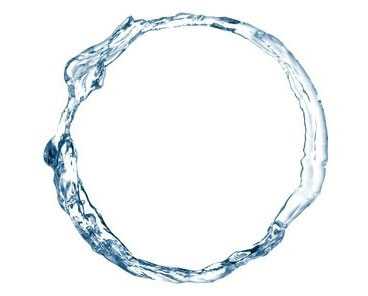
Electrolytes (sodium, potassium, magnesium and calcium) play an important role in ensuring the normal functioning of the body. They are responsible for metabolism and affect the composition of the blood. Excessive or insufficient intake of any one of these minerals leads to an imbalance. Sodium and potassium regulate water-salt metabolism: sodium ions retain water, and potassium removes it. Excess sodium in the body causes excess fluid to accumulate. Insufficient potassium intake also causes swelling.
The daily dose of sodium to maintain electrolyte balance is 1.5-3 g. Regularly exceeding this dose (more than 4-5 g) leads not only to edema, but also to increased blood pressure and kidney disease.
The main source of sodium in the body is food containing salt. Excessive consumption of salty foods is the main cause of morning swelling, but not the only one.
Another reason why water retention occurs is a high level of insulin in the blood, which stimulates the release of aldosterone, a hormone that retains sodium in tissues. Therefore, edema is also provoked by foods and drinks with a high glycemic index.
Thus, there are two main food groups that can retain water in the body. Let's look at each in detail.
Foods High in Sodium
All products containing large amounts of sodium in their composition are products that retain fluid in the body. The most common source of sodium is table salt (sodium chloride). Almost all food of animal and plant origin contains sodium chloride in its pure form:
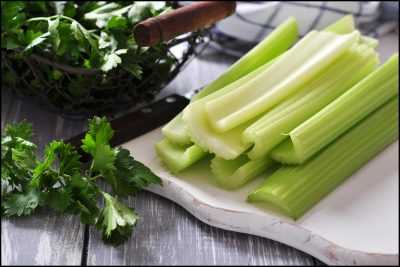
milk; seafood; meat; eggs; celery; legumes; cereals.
Their salt content is low, and their consumption is the minimum necessary to maintain electrolyte balance. But in the production of many food products, sodium is artificially added to them. Most often, manufacturers aim to enhance the taste and preserve the freshness of the product for as long as possible, so they add additional forms of sodium instead of salt:
sodium nitrite to improve color and as a preservative; monosodium glutamate to enhance taste; sodium saccharin – sugar substitute; sodium benzoate – keeps the product fresh for a long time (preservative); sodium bicarbonate (baking soda).
These forms of sodium are found in large quantities in all processed foods. We express the quantitative content of sodium salts in them in the table.
| Name of food products | Content of sodium salts, mg/100 g |
| Sausages: smoked sausage boiled sausages | 1300-1800 |
| Hard cheeses | 900-1300 |
| Hamburgers, sandwiches (fast food) | 1000-1200 |
| Sauerkraut | 800 |
| Canned fish | 400-600 |
| Canned meat (stew) | 500-700 |
| Bakery products: made from rye flour from wheat | 450 |
| Sea kale | 550 |
| Pickled olives | 1500 |
| Canned vegetables (peas, beans, corn) | 400-700 |
| Mayonnaise | 2000-3000 |
| Ketchup | 1500-1800 |
| Soy sauce | 5000 |
| Chips | 1000-1700 |
| Crackers, snacks | 800-1200 |
The food products noted in the table are leaders in salt content, so if you are prone to edema, they should be excluded from your diet first.
A small package of any salty snack or just a few slices of sausage provides several times your daily sodium intake. The constant addition of various sauces, even to healthy foods with low salt content, also leads to an overdose of this microelement, causing electrolyte imbalance and fluid retention in the body.
High glycemic index foods
Another group of foods that cause water retention are foods with a high glycemic index (GI). Its use causes a sharp release of insulin, which leads to the production of the hormone aldesterone. It retains sodium in the body's cells and causes swelling.
Below is a list of high GI foods:
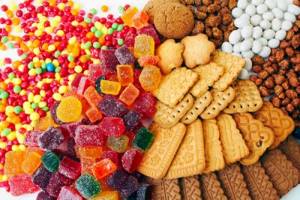
all sweets: chocolate, cookies, candies, halva, waffles, muffins; baked goods; dried fruits; bakery products; potato; cornflakes.
These foods, which retain water in the body, should also be limited if there is swelling and excess weight. When consuming dairy products with high fat content, the body also begins to produce aldesterone, so they can also be included in the list of foods that provoke water retention.
What foods retain fluid?
The first group of products includes foods with a high sodium content. The most popular substance is table salt - sodium chloride. This compound is present in most dishes of plant or animal origin.
We recommend: How can activated carbon be beneficial for our body?
Food:
- meat;
- milk;
- seafood;
- eggs;
- legumes;
- cereals;
- celery.
In such food, the amount of salt is low; when consumed, the body receives a strictly required amount of this substance. However, many manufacturers use specific compounds that contain sodium. Substances are specially added in large quantities to products to enhance their taste.
Additional substances:
- Monosodium glutamate – enhances taste.
- Sodium saccharin - used instead of sugar.
- Sodium benzoate – helps extend shelf life.
- Sodium bicarbonate is baking soda, used in baking.
- Sodium nitrite – improves the appearance of the dish.
Unfortunately, manufacturers add large amounts of such additives to food. When you eat food, your body receives a multiply increased dose of sodium. As a result, an overdose occurs and metabolism is disrupted.
The second group includes foods with a high glycemic index. These are foods that, when consumed, cause a sharp increase in insulin in the body. The synthesis of the hormone aldosterone, which retains sodium, is also accelerated. As a result, fluid accumulates in tissues and cells and swelling occurs. What products are included in this group?
Products:
- chocolate, sweets, baked goods;
- baking;
- dried fruits;
- any bakery products;
- potato.
It is recommended to limit such foods in the diet to people who are overweight and have constant swelling. Dairy products with increased liquid also provoke accelerated production of the hormone. Therefore, it is not recommended to abuse them.
Drinks that retain water in the body
When drinking some drinks, fluid will be retained rather than removed, so if you are prone to swelling, you should limit their intake. For example, beer and sweet carbonated drinks have a high glycemic index, and coffee in small doses has a diuretic effect, but when consumed in excess or with large amounts of sugar, coffee retains water in the body.
Drinking alcohol always causes swelling. Alcoholic drinks are strong diuretics; they remove fluid from the body, but at the same time disrupt the balance of all body systems, including water-salt balance. To remove toxins from the liver, water is needed, so all the liquid drunk after an alcoholic libation accumulates in the intercellular space and becomes the cause of edema.
Fluid removal products
The following products actively remove fluid from the body.
- Fruits (watermelon, strawberries, blueberries, viburnum). In case of kidney stone disease, these fruits should be used as food carefully so as not to cause an exacerbation.
- Tomatoes, asparagus, cabbage, leaf lettuce. They not only help remove water, but also help eliminate toxins and speed up metabolism.
- Buckwheat, greens, bell peppers, zucchini, pumpkin, beets.
- Diuretic teas made from chamomile, chicory, centaury, lingonberry and blueberry leaves.
How to deal with fluid retention in the body
The best way to get rid of edema caused by consuming foods and drinks that cause fluid retention is to completely limit them in your diet.
But due to various circumstances, it is not always possible to adhere to the principles of proper nutrition, so these foods and drinks can appear on any person’s menu. What can you do to minimize the risk of edema after eating foods that cause water to accumulate in body tissues?
To do this, you should follow several rules and recommendations.
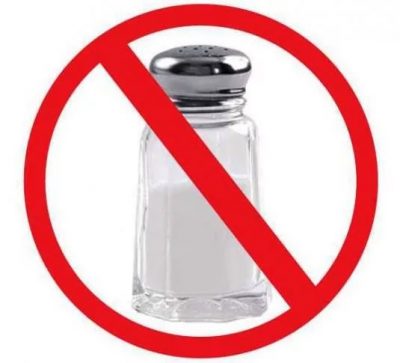
Drink as much clean, non-carbonated water as possible (at least 1.5-2 liters per day). At first glance, this seems illogical: if water accumulates, its intake should be reduced. But the body will react to the restriction of fluid with an even greater delay and will accumulate it “in reserve.” With sufficient fluid intake (except for coffee and sweet carbonated drinks), the need for water accumulation will disappear. Exercise and walk in the fresh air. This helps speed up metabolism, improve kidney function and remove excess water faster. If there is a lot of fluid in the body, a bath or a warm bath with sea salt and soda helps to successfully remove its excess. Try to salt foods as little as possible when cooking. The salt contained in the diet of a modern person is quite enough for the normal functioning of all organs (even without the use of various sauces, smoked meats and snacks). Consume foods and drinks high in potassium and fiber - they help to quickly remove excess fluid: green tea and hibiscus; dried apricots and raisins; berries, especially cranberries, blueberries, chokeberries; wheat bran; nuts; bananas; avocado; jacket potatoes; watermelons and melons; herbal teas from chamomile flowers, calendula, lingonberry leaves, blueberries, lemon balm; zucchini; cucumbers Use the juice of fresh vegetables (carrots, cabbage, beets) as a diuretic. It is prohibited to prescribe or drink pharmaceutical diuretics on your own - they are addictive and remove potassium, magnesium and calcium salts from the body along with sodium salts. Periodically arrange fasting days. Regular unloading on kefir, apples or milk tea prevents fluid stagnation in the cells (2 tablespoons of green tea are brewed in 2 liters of milk). To eliminate swelling caused by foods high in salt, you need to eat rice or oatmeal with water (unsalted, of course) for several days. This is a proven product used by athletes to dry their muscles before competitions.
If, after eliminating foods that cause fluid retention from the menu and following recommendations for preventing edema, they still occur and cause concern, this is a reason to consult a doctor for a comprehensive examination of the body. Perhaps the cause of swelling is a serious illness that requires medical intervention and medication.
Proper nutrition and an active lifestyle are the best means of preventing edema caused by the accumulation of fluid in the body. Daily consumption of clean water, fresh fruits, vegetables, meat and seafood, steamed or boiled, exclusion of fast food, sweets and industrial sauces from the diet is the key to excellent appearance, absence of swelling and health problems.
› ›
We often notice, especially in the mornings, that our face seems blurred, it is impossible to put a ring on our finger, and for some reason our shoes have become a little tight. This is fluid retention in the body. Many people suffer from this problem, especially in the modern rhythm of life. After all, it is our treatment of our own body that leads to such disappointing consequences.
If the body retains more fluid than it should, then all systems work under overload. There can be many reasons for this phenomenon: from genetic and somatic diseases to poor nutrition.
Compliance with the drinking regime is one of the important components that ensure a normal volume of fluid in the body. The daily dose of water for each person is 30-50 ml per 1 kg of body weight. A small adjustment is made depending on the time of year and air temperature. The more a person sweats, the more fluid he needs to drink to maintain hydration.
How to get rid of excess fluid in the body?
How to remove excess fluid from the body using available means and get rid of swelling? This question worries everyone who strives to become the owner of a beautiful figure and monitors their own health.
There are various ways to rid the body of excess fluid, but combination therapy, which includes proper nutrition, exercise and taking diuretics, is most effective.
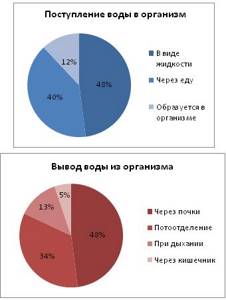
Fluid retention in the body
There are a number of foods that provoke fluid retention in body tissues. This:
| Product name | Table salt content (mg/100g) | % of daily value |
| Sauerkraut | 800 | 26.6 |
| Cheese | 800 | 26.6 |
| Cornflakes | 660 | 22 |
| Tuna canned | 500 | 16.6 |
| Rye bread | 430 | 14.3 |
| Green beans | 400 | 13.3 |
| Beet | 260 | 8.6 |
| Wheat bread | 250 | 8.3 |
| Chicory | 160 | 5.3 |
| Celery root | 125 | 4.1 |
| Cow's milk | 120 | 4 |
| Celery leaves | 100 | 3.3 |
| Raisin | 100 | 3.3 |
| Eggs | 100 | 3.3 |
| Fish | 100 | 3.3 |
| Veal | 100 | 3.3 |
| Spinach | 85 | 2.8 |
| Pork | 80 | 2.7 |
| Beef | 78 | 2.6 |
| Champignon | 70 | 2.3 |
| Oat flakes | 60 | 2 |
| Bananas | 54 | 1.8 |
| Potato | 30 | 1 |
| Red cabbage | 30 | 1 |
| Rosehip fruit | 30 | 1 |
| Cottage cheese | 30 | 1 |
| Green peas | 20 | 0.6 |
| Tomatoes | 20 | 0.6 |
| Dates | 20 | 0.6 |
| Oranges, nuts, almonds | 20 | 0.6 |
table salt and products that contain it: pickles, canned and pickled foods; sweets - cookies, cakes, sweet carbonated drinks, chocolate, honey, all kinds of syrups; fatty dairy products - butter, heavy cream, fermented milk products containing preservatives; sauces with preservatives and modifiers - mayonnaise, ketchup; spreads, margarines, hard cheese; chicken eggs; yeast products - white bread, baked goods, pasta; all types of smoking - meat, sausages, fish; fried foods with added oil; chips, snacks, crackers; tea, coffee (only sweet); alcoholic drinks of any strength; all products that contain preservatives, dyes and other synthetic additives; fast food.
To avoid swelling, which is only the first sign of a violation of water-salt metabolism, you need to exclude from your diet foods that retain fluid in the body.
Do this at least for a while so that your body can regulate its excretory processes and remove excess water on its own.
It cannot be said that in the modern world, with the current speeds and busy rhythm of life, a person will be able to completely refuse to consume foods that can provoke fluid retention. But avoiding their frequent use is simply necessary.
In order to quickly remove excess water from the body, include healthy foods in your diet that will help cope with this problem without medications. But this is only possible if you noticed the swelling in time, and it was not yet very strong.
If the problem turns out to be much more serious, you should consult a doctor. The specialist will prescribe adequate treatment. And he will advise you to include several other foods in your diet.
Products that remove liquid
There are a number of products that are very useful for fluid retention in the body:
fruits that have a pronounced diuretic property: watermelon, cranberry, viburnum, chokeberry, strawberry, blueberry. Before eating these fruits, it is advisable to do an ultrasound to find out about the presence of kidney stones. It should be used with caution in people suffering from renal failure. products - natural diuretics: buckwheat porridge, celery, parsley, dill, pumpkin, zucchini, bell pepper, beets, apple cider vinegar; products that help eliminate toxins and accelerate metabolic processes: lettuce, tomatoes, carrots, asparagus, cabbage; diuretic teas and decoctions of medicinal herbs: lingonberry and blueberry leaves (also help lower blood sugar levels), chamomile, calendula, chicory, centaury.
Products and vitamins that remove fluid
What to eat to prevent swelling?
There is a list of foods whose consumption will help prevent fluid retention. These are various fruits and vegetables, herbal drinks. What helps:
- green tea;
- hibiscus;
- dried apricots;
- raisin;
- cranberry;
- wheat bran;
- various nuts;
- bananas;
- jacket potatoes;
- cucumbers;
- zucchini.
We recommend: Intestinal congestion - cleansing methods without enemas
It is useful to drink tea from chamomile, lingonberry leaves, and blueberries. Watermelon and melon have diuretic properties. It is recommended to include buckwheat and rice porridge, lettuce, tomatoes, and herbs in your diet.
It is recommended to include foods rich in vitamin B6 in your diet: red meat, salmon. Low-fat dairy dishes and fruits contain beneficial elements B1, B5, D. It is important that the body receives calcium, magnesium and potassium - substances that stimulate the removal of excess fluid.
Vitamins
A lack of vitamins, amino acids and microelements can also lead to fluid retention in the body. It is imperative to include the following foods in your diet:
containing vitamin B6: salmon, red meat, tuna, bananas, brown rice. This vitamin also helps normalize digestive processes; containing vitamins B1, B5 and D: low-fat dairy products and fresh fruits. These products also have a beneficial effect on the state of the nervous system, bone tissue and metabolic processes; trace elements calcium, manganese, potassium, magnesium. They are found in large quantities in greens, spinach, melons and citrus fruits. In addition, these products actively fight viral infections and help improve immunity.
In order for the body to fully get rid of excess fluid, toxins, waste and other products of processing and vital activity of the body, it is necessary to maintain a drinking regime.
You need to drink clean, high-quality water. Juices, compotes, teas, fruit drinks and other liquids that we often try to replace water with will not bring any benefit. If the liquid contains sugar, honey, minerals and other natural ingredients, it is already food. And water should enter the human body in its pure form. Some nutritionists recommend using structured water as a water resource. This is water that has undergone a cold purification process - freezing.
What you need to do to get rid of excess fluid in the body:
drink clean water in the amount of 1.5-2 liters per day. Soon your body will understand that it has enough water and will stop storing it in its tissues for future use. The swelling will go away. Eliminate salt as much as possible. As you know, salt retains water in the body. It also masks the real taste of the product. If you gradually get used to less salty foods, you may notice and discover a completely new taste of familiar foods. But completely unsalted food is not always good either. After all, table salt is the main source of sodium for the human body. Walking in the fresh air and dosed physical activity will help speed up metabolic processes. This will also lead to the removal of excess fluid from the body. Proper diet. Make it a rule to start the day with breakfast, which must include oatmeal, cooked in water without salt or sugar. Add dried fruits, cinnamon, turmeric to it. If you really can’t bear it and want something sweet, a spoonful of honey will replace sugar and serve as a source of glucose. You can vary your breakfast and replace oatmeal with other cereals - buckwheat, brown rice, corn. Corn is almost the only grain that contains gold elements that can be absorbed by the human body. Be sure to eat fresh vegetables, fruits and wholemeal bread every day. This is a source of “correct” carbohydrates, which will not only help remove excess water from the body, but also provide it with the necessary energy for the whole day. Low-fat fermented milk products, lean meats, fish and legumes are the most correct and healthy source of proteins, without which the normal functioning of the body is simply impossible. Replace sugar, baked goods and synthetic sweets with natural ones - dried fruits, nuts, honey and dark chocolate in small quantities.
The human body is 75% fluid, but too much of it can cause big problems. Edema itself can occur for various reasons. One of them is a warning about impending troubles or a predisposition to some kind of disease.
You just need to learn to understand your body language. It sends us signals that we often ignore for a reason. Morning swelling is a reason to think about your health. And of course, take action.
| Products that retain fluid in the body |
We recommend studying: Beauty and Health Health
Most people are familiar with the problem of edema and excess fluid in the body. Often, when we go to the mirror in the morning, we notice that our face seems to be swollen or “blurred.” In the arms and legs, swelling is also detected visually, and by other signs: shoes are too tight, and the straps of summer shoes cut into the skin; In winter, it can be difficult to zip up boots.
If you feel “heaviness in your legs”, but the swelling is not noticeable in appearance, you can press your finger in the area of the shin: a trace remains - there is swelling.
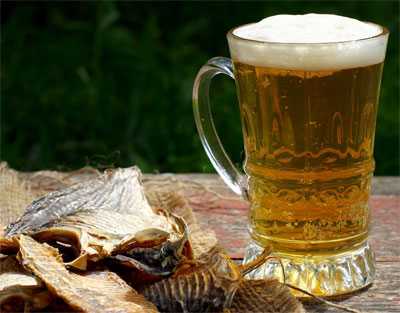
Photo: products that retain liquid
Preventing fluid accumulation
- Drink at least two liters of water per day.
- Reduce the amount of salt and sugar, or eliminate their consumption altogether. Sugar can be replaced with fruits and natural honey.
- Adhere to a balanced and healthy diet, including fruits, vegetables, cereals, and lactic acid products.
- Eat dried fruits, raisins, nuts, dark chocolate (in small quantities).
- Do not forget that doing physical exercise is useful, and walking in the air speeds up metabolism and leads to more active diuresis.
- Do not use diuretics without a doctor’s prescription, so as not to cause dehydration.
Maintaining the correct drinking regime and reducing foods that retain water in the diet protect the body from many diseases.
Where does swelling come from?
Determining the cause of “swelling” of tissues and the occurrence of swelling is not always easy - competent medical diagnosis is needed.
For example, more fluid enters the body than is excreted; electrolyte balance or metabolism is disrupted; there are diseases of the gastrointestinal tract, heart, liver or kidneys.
Fluid may be retained due to lack of exercise, poor posture, hot weather, working in one position - sitting or standing, taking certain medications - including contraception, wearing tight (uncomfortable) clothes and shoes. In women, edema can also be accompanied by PMS, and in most cases, pregnancy, although this cannot be considered the norm.
When water is retained in the tissues, the body has to work under conditions of serious overload. This can last for months and even years: many people here simply get used to their illnesses and believe that “nothing can be done about it.”
Sometimes, having discovered a tendency to edema, a person tries to limit fluid intake, but the problem does not go away. The swelling remains, the state of health does not improve.
The body needs to remove toxins - this requires water. If there is not enough of it, the body waits until it has enough, and the kidneys stop working at full capacity. But, having received such problems, people do not calm down, and resort to diuretic tablets: the liquid accumulated “with difficulty” is forcibly removed, and the process begins anew.
What to do to avoid fluid retention and edema? Remove foods that retain fluid from your diet or reduce their consumption to a reasonable minimum. If the swelling is severe, you should give up such foods completely for a while, give the body time to come to its senses and remove excess water without strain. True, many people think that they cannot do without these products, and they ask the question: what then to eat?
Products that retain fluid
First of all, “fast food” and ready-made products from the store: bring it home and eat. In the first place are any smoked and canned goods – meat and fish, salted fish “to go with beer”, like the beer itself. Any alcohol causes swelling: the body actively fights dehydration, tries to restore the acid-base balance, and generally return to normal. Chips, crackers and other snacks rich in salt also force the body to retain fluid.
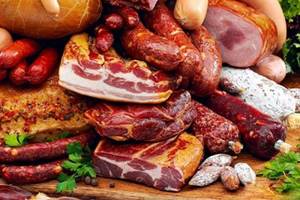
Photo: products that retain liquid
In general, salt is contained in many products, and in considerable quantities, and we also add it to dishes consisting of these products: for example, we salt salads with sausage, cheese and mayonnaise. Any fried food also retains water, be it potatoes, meat or golden-brown pancakes. And by pouring ketchup on potatoes and pasta, we seriously complicate the work of the kidneys, which already have a hard time.
Fatty homemade sauces, pickles and marinades, canned compotes, high-fat dairy products, eggs, baked goods (especially white flour), store-bought sweets - from cakes and soda to chocolates and syrups, semi-finished products, aged cheese, margarines and spreads, juices with sugar, sweet tea and coffee - this is not a complete list of products that contribute to fluid accumulation.
Let's talk about some products in more detail. There may be doubts about coffee: this popular drink is known to have a diuretic effect. This is true if you drink coffee without sugar, and in large enough quantities - at least 3 cups. But we usually drink sweet coffee, and even with cookies, and the liquid is retained rather than removed.
Everyone knows about the benefits of milk, cottage cheese and yoghurt, but when consuming high-fat milk, the body begins to produce more insulin, the presence of which enhances the work of the adrenal glands: they produce a hormone that retains sodium salts.
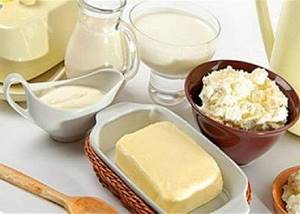
Photo: products that retain liquid
To stay healthy, a person only needs 2.5 g of salt per day, which is less than 1/3 tsp, so, to be objective, food does not need to be salted at all. Why? But because salt is hidden in natural, natural products, and not just in store-bought, ready-made and semi-finished products.
So, a serving of regular beets, peas or red cabbage can contain up to 9% of the daily salt requirement; in pasta and cereals - up to 14%, in greens and mushrooms - from 3 to 15%, etc. This seems like a trifle, but we salt food when cooking, and even add “something salty” to “brighten up” the menu.
Sauerkraut is a healthy vitamin product, but it must also be used wisely: it contains a lot of salt - up to 800 mg per 100 g.
Another point is water retention due to excess creatine. This compound enters the body mainly with meat and fish, and is partially synthesized by the kidneys, liver and pancreas. Creatine is a source of energy for muscles (that’s why athletes take it as a supplement), but with our modern lifestyle we use it negligibly – less than 2 g per day. And we eat meat and fish dishes almost every day, and more than once; excess creatine works to accumulate water - up to 2 liters, even if the swelling is “not visible to the eye.” To restore fluid balance, you do not need to take diuretics or reduce your drinking regimen; on the contrary, you need to drink up to 3 liters of clean water per day, along with a salt-free diet, until the swelling “goes down”.
Hidden salt can also be “found” in very healthy products, although at first glance this seems strange. From 2 to 8% salt contain corn and oat flakes, chicory, green beans, rye bread, potatoes, celery (root), spinach, bananas, raisins, oranges, dates, rose hips, nuts, tomatoes, etc.
